This site is made possible by its sponsors.
Please visit them!
oaktag - A thin but stiff card or cardboard, the kind used in the typical manilla file-folder.
Also see bristol board, illustration board, paper, and vellum.
oban - In Japanese tradition, a size of paper used for prints, measuring about 15 x 10 inches.
Also see chuban.
obelisk - A tall, four-sided shaft of stone, usually tapering, that rises to a pyramidal point. A monolith is sometimes an obelisk. Often placed at the entrances of Egyptian temples in ancient times, obelisks continue to be favored as a shape for monuments in the Western world.
(pr. AH-bə-lisk)
Examples:
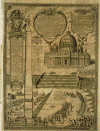
G. Guerra, Procession of 1587 to Mark the Erection of the
Cross at the Top of the Vatican's Egyptian Obelisk, engraving.
One of Pope Sixtus's most ambitious projects was to move the
Vatican's obelisk to its present position in front of Saint Peter's.
Though Michelangelo refused this project ("What if it breaks?"
he asked), Domenico Fontana carried it out. This engraving commemorates
rituals that accompanied the erection, exorcism, and rededication
of this obelisk.

USA, Washington Monument, Washington,
DC. The construction of this monument began in 1843, but wasn't
completed until 1884. Rising 555 feet above the National Mall,
as designed by architect Robert Mills, it remains the tallest
building made of stone. This obelisk was first suggested by Washington,
DC's master-planner, Pierre L'Enfant, as the centerpiece for
America's capital city.
object - A material thing. Something to which attention, feeling, thought, or action is directed, therefore usually conceived as subhuman, unreflective and passive, in contrast to the active subject. It is common, for example, for feminist criticism to describe a female nude as the object of the male gaze. Such figures are thus oppressed (see oppression). When the female figure exhibits a less passive personality, as in the painting by Edouard Manet (French, 1832-1883) of Olympia, 1863, oil on canvas, 51 3/8 x 74 3/4 inches (130.5 x 190 cm) Musée d'Orsay, Paris; she is sometimes described as a subject, at least with respect to the single issue of her gaze.
(pr. AHB-jək; but for a French pr.: ohb-ZHAY)
Examples of the range of other types of works referred to as decorative objects, or objects:
![]()
Attributed to Jacques Caffieri (French, 1678-1755),
Paris, after 1749, Compound Microscope and Case, gilt
bronze, enamel, shagreen, glass;
case of wood, tooled and gilded
leather, brass, lined with
velvet, silver braid, and silver
lace, 1 foot 6 7/8 x 11 x 8 1/16 inches (48 x 28 x 20.5 cm),
J. Paul Getty Museum, Malibu, CA.
![]()
After designs by Pierre Contant d'Ivry, architect, French, Paris, 1756, Wall Lights, gilt
bronze, 3 feet x 1 foot 9 inches
x 1 foot 2 inches (91.5 x 53.0 x 35.0 cm), J. Paul Getty Museum,
Malibu, CA. See Rococo.

George Washington's Dentures, c. 1785, carved wood,
metal, Smithsonian Institution,
Washington, DC.
Also see accession, artwork, commision, commodity, deaccession, donation, Fluxus, gallery, memorabilia, museum, objectification, piece, placeholder, realia, registrar, shadow box, and vitrine.
objectify and objectification - To depersonalize; turning something or someone into an object. The term is very commonly used to describe the dehumanizing oppression of women, non-whites, and the dispossessed. To do the opposite is to subjectify.
Quote:
Also see accession, commision, commodity, deaccession, and oppression.
objectivity - Being influenced by facts instead of by emotions or personal prejudices. The opposite of objectification and subjectivity.
Quote:
objet d'art - A French term meaning art object; it is often used by English speakers to mean a work of art which is small in size, such as a miniature painting, netsuke, a statuette, or vase.
(pr. ohb-ZHAY dahr)
Also see bibelot and masterpiece.
oblique - Having a slanting or sloping position or direction; inclined, diagonal. May refer to a style of type that slants to the left, as opposed to the italic style, which slants to the right. Obliques are rarely used in printing except for special effects.
(pr. oh-BLEEK)
Also see bevel, bias, declivity, font, and projection.
![]()
![]()
oblong - A shape stretched out from a circle or square shape so that it is longer than it is wide.
(pr. AH-blöng)
Also see curve, ellipse, oval, ovoid, and pestle.
obscene - Offensive to accepted standards of decency or modesty. Lewd. Or, more broadly, repulsive or offensive to the senses. Obscenity is the state or quality of being obscene.
Also see bad art, coarse, erotica and erotic art, feminism and feminist art, First Amendment rights, fig leaf, beauty, grotesque, love, nude, pain, pornography, sensuality, sex, sybaritic, and voyeurism.
obsession - Excessive preoccupation with a fixed idea or an unwanted feeling or emotion. A compulsive, often unreasonable idea or emotion. Whenever an artist works on a piece or a body of work that involves an impressive accumulation or production of material, marks, or gestures, a critic might characterize the artist or the work as obsessive. A psychologist might call this obsessive-compulsive behavior. Anything that involves highly repetitive movements, takes a long time, is highly stylized, took stupendous energy or craftsmanship to produce could be interpreted as having been the product of obsessive behavior. Many of the greatest works of art took a long time to produce. Unless it is truly deranged or mindless (monotonous), such work might also be described as showing the extent to which the artist can focus his energy. Consider animated filmmaking and art lexicography, for instance. Nevertheless, works by folk, self-taught, mentally ill, and other outsider artists have often been noted as resulting from obsessive behaviors such as seen in horror vacui, and many critics have made powerful cases in support of such work.
Also see Aboriginal art, achievement, art brut, attention, attitude, bias, Collyers' Mansion, effort, expression, expressive qualities, focus, gestalt, meaning, memory, monotony, motivation, naive, paint-by-number, pattern, perception, pique assiette (also called picassiette), point of view, primitive, rhythm, Stendhal syndrome, and stylize.
obtuse angle - An angle greater than 90° but less than 180°. The first two of the angles below are obtuse. The third one is 90°, also called a right angle. The last of the four is an acute angle.

obverse - The principal side of any object, especially any two-sided object, such as a coin, a medal, a seal, or a panel which has a painting on each side. The opposite of obverse is reverse. The front and rear sides of works on paper are more often referred to as recto and verso.
Also see numismatics.
occlude - To close to a tight enough fit, as do the pieces of a puzzle, or a lid onto a jar or box. Needs for occlusion might include preventing light, air, liquids, or other things from passing through. Dentists are concerned that the teeth of the upper and lower jaw occlude when brought together.
(pr. AHK-klood)
ocher or ochre - Natural earths used to make pigments, especially yellowish tan. Adjectival forms are ochery and ocherous.
(pr. OH-kər)
Related links:

octagon - A closed two-dimensional polygon bounded by eight straight-line segments.
The formula with which to find an equilateral octagon's area is 4.8284 times the length of one side squared.
Examples used in art:

Frans Hals (Dutch, born after 1580, died
1666), The Smoker, c. 1623-25, oil
on wood panel,
octagonal, 18 3/8 x 19 1/2 inches (46.7 x 49.5 cm), Metropolitan
Museum of Art, NY. The octagonal shape
of this panel is original.
Alessandro Algardi (Italian, 1598-1654), Pietà, 1630-40, octagonal bronze relief (a rectangular frame conceals corners), excluding flange: 11 3/4 x 11 3/4 inches (29.8 x 29.8 cm), Frick Collection, NY. See Pietà.
Also see mathematics, radial, and shape.
 octahedron - A polyhedron
with eight triangular faces.
The sides of a right octahedron are identical isosceles triangles.
The regular octahedron is one of the five Platonic solids (along
with the tetrahedron, hexahedron
(cube), dodecahedron,
and icosahedron).
octahedron - A polyhedron
with eight triangular faces.
The sides of a right octahedron are identical isosceles triangles.
The regular octahedron is one of the five Platonic solids (along
with the tetrahedron, hexahedron
(cube), dodecahedron,
and icosahedron).
octavo - A book or manuscript of the third largest standard size, usually measuring 20-25 cm (8-9 1/2 inches) in height, and 13-15 cm (5-6 inches) in width, which is composed of sheets of paper folded into eight leaves ("oct-" is from Latin for eight). The plural form is octavos. Abbreviated o, O, O., oct., Oct., and 8vo. Also called eightvo.
(pr. ahk-TAH-voh)
Also see bookbinding, duodecimo, folio, quarto, rotulus, sextodecimo, signature, text, tricesimo-segundo, and vicesimo-quarto.
oculus - A round, central opening or "eye" in a dome.
(pr. AH-cyə-ləs)
Example:

Interior view of the Pantheon, Rome, 118 CE.
At the top of the Pantheon's coffered dome is its oculus. In this photo, sunlight projects through this open hole to the sky. There has never been any glass or other cover on this opening. Anticipating the rains, the Romans placed twenty-two small drains in the floor. They continue to function well today.
Also see circle, fenestration, lantern, lunette, omphalos, and pantheon.
oenochoe - An ancient Greek wine pitcher.
(pr. ə-NUK-oh-ee)
Example:
![]()

Greece, Attic, Head Oenochoe, 475-450 BCE,
ceramic.
Also see ewer, vase, and vessel.
oeuvre - The collected works of an artist. Literally, this is the French word for work.
(pr. OO-vrə)
Also see catalogue raisonné and collection.
offset printing - The printing process in which an inked image on a metal or paper plate is transferred to a smooth rubber cylinder and then to the paper.
Also see lithography and planography.

ogee - An edge or
molding having in profile
(as seen in the cross-section
 views seen here) a recessed or
an S-shaped curve, the latter
is also known as a Roman ogee. Also, an arch, each side of which has this form.
views seen here) a recessed or
an S-shaped curve, the latter
is also known as a Roman ogee. Also, an arch, each side of which has this form.
(pr. OH-jee)
Also see bevel, chamfer, and flute.
ogive, ogival - An ogive is a diagonal rib of a Gothic vault, or it's a Gothic (pointed or lancet) arch. Ogival is the adjectival form of the word, often used in reference to arches of this style.
(pr. OH-ji:v)
The adjectival form is ogival. (pr. OH-jə-vəl)
Example of the first sense:
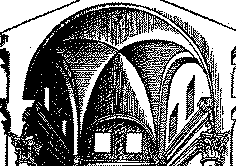
Ogives in a Gothic cross
vault designed
by architect
Leon Baptiste Alberti (Italian, 1404-1472). Seen from this oblique point
of view, the ogives resemble a drooping X. See a larger view.
oil - See ink, linseed oil, machine oil, oil gilding, oil paint, oilstone, paraffin, and wax.
oil gilding - Also known as mordant gilding, this is attaching gold leaf to a non-absorbent surface which has been coated with a mordant size (an adhesive) — either a slow-drying type containing linseed oil, or a quick-drying type sometimes called japan gold size. The leaf must be applied only when the mordant size is no longer wet, but is somewhat sticky or tacky. If the surface is absorbent, it must first be sized with some kind of shellac, varnish, or paint. Oil gilding is generally easier than water gilding. One advantage is that oil gilding can be applied to wood or stone without first coating them with gesso. However, it cannot be burnished (water gilding can be), and it is not so long-lasting (the oil likely to darken or to show some other decay).
Also see fire gilding and gilt.
oil paint - Slow drying paint made when pigments are mixed with an oil, linseed oil being most traditional. The oil dries with a hard film, and the brightness of the colors is protected. Oil paints are usually opaque and traditionally used on canvas. They can have a matte, semi-gloss, or glossy finish. To look at examples of works in oil paints, see the articles under the names of every period from the Renaissance onward.
Here are examples of particularly early oil paintings:

Giovanni Bellini (Italian, c. 14301516),
Giovanni
Emo, c. 1475-83, oil on wood
panel, 19 1/4 x 13 7/8 inches (49
x 35 cm), National Gallery of Art, Washington, DC.
Giovanni Bellini, St. Francis in the Desert, c. 1480, tempera and oil on wood panel, 49 x 55 7/8 inches (124.4 x 141.9 cm), Frick Collection, NY.
Related resources:
Also see pellicle, pochade, primer, stain and stain removal, and the names of various oil painting techniques, such as abbozzo, alla prima, impasto, overpainting, and underpainting.
oil pastel -
Examples of works in oil pastel:

Yolanda López (American, 1942-), Portrait of the Artist as the Virgin of Guadalupe,
1978, oil pastel on paper, 32 x 24
inches, collection of the artist. See Chicana art, flag, and mandorla.

Fernando Casas (American, 1946-), An Eye for Self-Development, 1986, oil
pastel on paper, 48 x 84 inches (122
x 213 cm). See conté crayon
and oval.
Also see pastel.
oilstone - A stone used for sharpening and honing metal cutting tools.
oinochoe - A Greek vessel or vase in the form of a one-handled wine jug. Among the various types of Greek vases are the alabastron, amphora, hydria, kantharos, volute and calyx krater, kyathos, kylix, lekythos, oinochoe, pelike, pithos, pyxis, and rhyton.
old master - Traditionally, a distinguished maker of pictures or sculptures who was active before 1700 — during the Renaissance, Mannerist and Baroque periods, especially Italian, Dutch and Flemish artists. Today the term is also being used to refer to recognized masters of the eighteenth century.
Also see canon, Dutch art, and master.
omphalos - A central point, a hub or focal point, or the center of activity. "Omphalos" originally meant navel or umbilicus (bellybutton) in ancient Greece. When placed as a boss at the center of a vessel or of a shield, an omphalos symbolized the center of the world. The ancients also used it to designate a circular altar at Delphi, which was considered the center of the earth.
(pr. AHM-fə-lös)
"Omphaloskepsis" is a practice that appeared among English speakers in the 1920s, and means "contemplation of one's navel."
Example:

Hellenistic, Phiale, c. 300 BCE, repoussé gold, diameter 23 cm, Metropolitan Museum of Art, NY. In the center of this phiale is a large omphalos, surrounded by a radial pattern of acorns and bees, both of these symbolize the earth's "victual in plenty," as described by Hesiod.
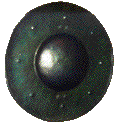
The boss
at the center of this shield is reminiscent of the omphalos on
the shields of ancient Greece. A type of shield popular in England
in the 13th and 15th centuries, this shield was known as a "buckler,"
made mostly of leather, entire diameter
about 14 inches. Much smaller bosses encircle the large central
one. See arms
& armor.
Quote:
![]()

![]() 1-bit image - A digital image with one bit allocated for the storage of each pixel, meaning 2 different colors are possible —
1-bit image - A digital image with one bit allocated for the storage of each pixel, meaning 2 different colors are possible — black and white.
Also see 2-bit image, 3-bit image, 4-bit image, 8-bit image, 12-bit image, 16-bit image, 24-bit image, and 32-bit image.
oneiric - Of or pertaining to dreams.
Also see cryptic, fanciful, fantastic, fantasy, gestalt, mystery, Rorschach test, Surrealism, and Symbolism.
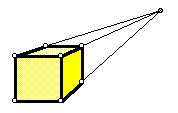
one-point perspective - A form of linear perspective in which all lines (describing straight edges that go from points nearer to points farther) appear to meet at a single point on the horizon.
Also see depth and two-point perspective.
online art or online-art - A type of new media, art created solely or principally to be seen on the World Wide Web (WWW). Typically, these works are dependent upon the latest Internet languages, plugins, etc., many interactive, with motion and sound components, and sometimes involving telephones, cameras, and all sorts of other peripheral devices.
See links at new media.
ontbijt - A type of still life painting, Dutch for "breakfast piece."
Examples:

Willem Claesz. Heda (Dutch, 1594-1680/2),
Breakfast with a Crab, 1648, oil
on canvas, 46 1/2 x 46 1/2
inches (118 x 118 cm), Hermitage Museum, St. Petersburg, Russia.
Heda and Pieter Claesz were the masters
of the Dutch ontbijt. See Dutch art.

Pieter Claesz (Dutch, 1597/98 - 1660), Still Life with Two Lemons, 1629, oil on wood
panel, 16 7/8 x 23 3/8 inches (42.7
x 59.3 cm), Cleveland Museum of Art.

Could such sculptures
by Daniel Spoerri (Swiss, 1930-) as Prose Poems, 1959-60, 27 1/.8 x 21 3/.8
x 14 1/4 inches (69.0 x 54.2 x 36.1 cm), Tate Gallery, London
— an actual meal as abandoned on a board — be considered ontbijt?!
See Fluxus and
rhopography.
Also see Dutch art and vanitas.
ontology - The branch of philosophy that studies the nature of being, the area of metaphysics relating to the being or essence of things, or to being in the abstract.
Related link:
Also see empiricism, epistemology, interdisciplinary, phenomenology, and science and art.
opacity - The quality of being opaque. In painting, the power of a pigment to cover or obscure the surface to which it is applied. When opacity is not complete, it can be described as translucence, or as opaque from 99% down to 1%. The equivalent of 0% opacity is transparency.
(pr. oh-PA-sə-tee)
Also see white lead.

![]()
 opalescence - A white surface
having iridescence. In opal
gemstones this "play of
color" is caused by tiny spherical
formations of silicon inherent
in this stone's structure.
These spheres, and the spaces
in between, refract white light much as a diffraction grating
spectroscope, separating wavelengths of the various spectral colors.
The colors seen depend on the size and distance between the spheres
in the opal's structure.
opalescence - A white surface
having iridescence. In opal
gemstones this "play of
color" is caused by tiny spherical
formations of silicon inherent
in this stone's structure.
These spheres, and the spaces
in between, refract white light much as a diffraction grating
spectroscope, separating wavelengths of the various spectral colors.
The colors seen depend on the size and distance between the spheres
in the opal's structure.
Example:
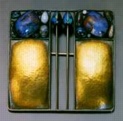
Josef Hoffmann (Austrian, 1870-1956) for
Wiener Werkstätte, Square Brooch, silver lattice, repoussé gold, and opal, c. 1905. See Art Nouveau, jewelry, and secession.
Also see fluorescence, fluorescent colors, glaze, glitter, and semi-gloss.
opaque - Something that cannot be seen through; the opposite of transparent, although something through which some light passes would be described as translucent.
(pr. oh-PAYK)
Also see opacity.
opaque projector - A device using a bright lamp, lens and mirrors to project an enlarged image of an opaque image or object onto a flat surface, usually so that its image may be traced. At the end of the nineteenth century, it replaced a somewhat similar device called a camera lucida, which had earlier replaced another called camera obscura. There are various other sorts of projectors also in use today. Digital versions are rapidly overtaking opaque projectors in popularity.
Example:

Kintronics DP-60. The manufacturer describes
this opaque projector as projecting an image from virtually any
material, including transparencies, printed materials, and even three-dimensional
objects.
open edition - A set of prints made in an unspecified or unlimited number of impressions. The opposite of open edition is a limited edition.
opening - An event which celebrates the beginning of an art exhibition.
Also see gallery, museum, vernissage.
open shape - In an artwork, space that is not completely enclosed by a line. A mass penetrated or treated in such a way that space acts as its environment rather than as its limit. For example, a doughnut having a hole in its middle has an open shape in its middle.
Also see closed shape and empty shape.
openwork - Openwork is what many call any object or architectural construction produced in such a way that it shows a pattern of openings (perforations, piercings, gaps, holes), typically to decorative effect. Such works can be in cloth, metal, or wood. When referring to work in fabric, it likely to be embroidery with decorated holes either the embroidery technique or the embroidery itself in which holes are formed in a fabric by either cutting or pulling threads and then embellishing with various stitches. "Openwork" might also be used to refer to a quarry. The earliest known use of this term in English is 1598.
Examples:

China, Dancer-Shaped Pei Pendants, Western Han
Dynasty (206 BCE
- 25 CE),
white jade, 4.6 x 2.5
cm, Henan Museum, China. Unearthed at Yongcheng, Henan. This
pair of pei pendants is
carved in openwork and engraved
lines. See dance and Han.

Korea, Openwork
Incense Burner, first half of the 12th century, celadon
glazed porcelain, height
15.3cm, National Museum of Korea. While fulfilling its function,
the design of
this incense burner juxtaposes
plant and animal motifs
with geometric openwork. See
Korean art.

Persian, Openwork Lamp or Incense Burner, Seljuk
Dynasty, 12th century, bronze,
height 16.5 cm (6 1/2 inches),
Detroit Institute of Arts, MI. This lamp or incense burner is
decorated with Kufic inscriptions
bestowing blessings on the owner. Openwork designs of linked
roundels and intertwined
palmette scrolls adorn the
surface.
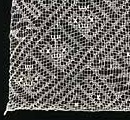
South America, Central Andes, Central Coast,
Chancay, Openwork Headcloth, Late Intermediate
Period, 1000-1470 CE,
cotton, embroidered square
mesh openwork, 32 x 32 inches (81 x 81 cm), Michael C. Carlos
Museum, Emery U, Atlanta, GA. See Pre-Columbian
art.
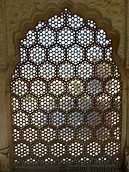
India, Rajahstan, a window in the Amber Palace, no date, jalee
work — carved from
marble, pierced in an intricate openwork
pattern.
Also see basketry, fenestration, filigree, fret, iron, jalee work, lattice, wire, wrought iron.
ophthalmology, ophthalmologist - Ophthalmology is the branch of medicine that deals with the anatomy, functions, pathology, and treatment of the eye. An ophthalmologist is a doctor whose specialty is this branch of medicine.
Also see aqueous humor, colorblind, interdisciplinary, iris, lens, light, optical, perception, photoreceptors, pupil, refraction, retina, rods and cones, science and art, seeing, sight, and vitreous humor.
oppression - The act of oppressing; unjust and arbitrary use of power. Or, the state of being oppressed. In art, oppression may be observed in any representation of any one people as inferior to others.
Also see censorship, different, ethnocentrism, First Amendment rights, multiculturalism, objectification, politically correct (PC), and xenophobia.
optics and optical - Of or relating to sight; visual. Optics can more specifically refer to instruments designed to assist sight, or uses of light-sensitive devices, such as eyes, cameras, photo-electric cells, etc.
Example:

French (Paris), about 1751, Compound Microscope with Case, microscope:
gilt bronze,
glass and mirror
glass, enamel, and
shagreen, 18 7/8 x 11 x 8 1/8 inches; case: wood,
tooled leather,
brass, velvet, and silver,
and lace, 26 x 13 3/4 x 10 5/8 inches, J. Paul Getty Museum,
Malibu, CA. This is one of 22 objects in the Devices of Wonder exhibit catalogued online
by the Getty Museum — best seen with Flash and RealAudio plugins.
Also see afterimage, anamorphosis, art, artist, binocular vision, blind spot, colorblindness, definition, elements of art, filter, fish-eye lens, gestalt, interdisciplinary, kaleidoscope, lens, magic lantern, moiré, night blindness or nyctalopia, opaque projector, Op Art, ophthalmology, optical illusion, optical mixing, perception, peripheral vision, photography, photoreceptors, principles of design, push and pull, refraction, science and art, seeing, stereoscopic vision, subliminal message or subliminal advertising, telephoto lens, telescope, wide-angle lens, visual qualities, zoetrope, and zoopraxiscope.
Optical Art - See Op Art.
optical mixing - The process by wich the eyes blend bits of pure color placed next to each other in an image.

In a picture, this means the merging of juxtaposed dots or brushstrokes of pure colors when seen from a distance to produce a hue often more luminous and saturated than that available from a premixed pigment. Optical mixing is important in Impressionist and pointillist painting.
Other Internet resources concerned with optical mixing:
Also see complementary colors, definition, photoreceptors, retina, science and art, and subliminal message or subliminal advertising.
https://inform.quest/_art